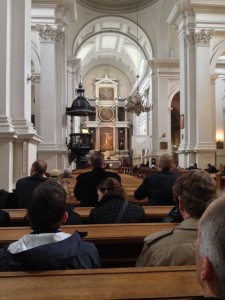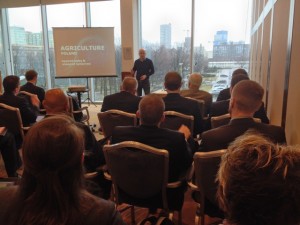International Study Seminar, Day 8
Sunday, March 16, 2014
– written by Lynda Gould, Andy Brantner, & Patrick Maschhoff – Presiding Fellows
We started the morning as a group with a short walk to Kościół Wszystkich Świętych (a large local Catholic cathedral). As observed by our Catholic members, church was church… with few exceptions. Confession was held during mass, children were an important part of the sermon, and of course, everything was in Polish.
After church, we noticed the city was very quiet on a Sunday with minimal businesses open.
This afternoon, we met with Paweł Szóstak, National Sales Manager, Monsanto Poland, in our hotel. He gave us not only an overview of Monsanto’s business in Poland, but also a general idea of agriculture in general in this area. Monsanto focuses on three primary entities, which included DeKalb (crops), Roundup (pesticides), and Seminis (vegetable seeds). There are two million growers in Poland, producing primarily cereals, oilseed rape, corn, potatoes, and sugar beets. Farmers are generally split into three categories, with 50,000 farmers controlling greater than 50 hectares (124 acres), 3000 farmers controlling greater than 1000 hectares (2470 acres), with the large remaining numbers of farmers managing small farms of 5-30 hectares (12-74 acres).
We found a few striking differences between Polish and American grain farming. Most farmers pay no income tax. Also, direct payments are paid to land owners based on hectares owned (in other words, renters rarely benefit from European Government CAP payments). Direct foreign ownership is not legal, but also cost prohibitive.
Dinner this evening was at Folk Gospoda, a traditional Polish restaurant that served delicious food family-style. Depending on where you sat, the favorite foods included pickled herring, seasoned catfish, or breaded pork.


Comments are closed